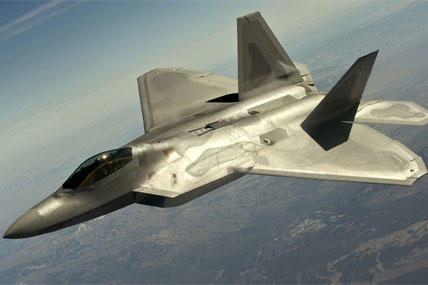Some of the most advanced aircraft in the U.S. arsenal will miss this year’s Paris air show due to federal budget cuts, freeing up more space for the governments of France and Russia to showcase their latest planes, helicopters and drones.
Among the U.S. aircraft notably missing in action: the fourth-generation F/A-18 Super Hornet and fifth-generation F-22 Raptor and F-35 Lightning II fighter jets; the V-22 Osprey tilt-rotor craft, which takes off like a helicopter and flies like an plane; the RQ-4 Global Hawk drone, the biggest unmanned aircraft in the fleet; even the C-130J cargo plane.
Faced with across-the-board budget cuts and increased scrutiny of travel spending, the Defense Department has scaled back its presence at air shows everywhere, not just marquee international events such as Paris, which is billed as the oldest and largest show of its kind. The Navy, for example, this year canceled the rest of the season for the Blue Angels, an elite demonstration team that performs aerobatics in F/A-18s at air shows across the country.
While some officials from its Foreign Military Sales program will attend the event at Le Bourget airfield outside Paris, the department won’t be flying aircraft there because of an April 1 order that “suspended all aerial demonstrations, including flyovers, jump team demonstrations and participation in civilian air shows and military open houses,” Maureen Schumann, a spokeswoman at the Pentagon, said in an e-mailed statement. “This guidance is in effect until rescinded.”
Lockheed Martin Corp., the Pentagon’s biggest contractor, will only send a handful of employees to the show. Northrop Grumman Corp., another top defense contractor, will skip it entirely, just as it did last year’s Farnborough International Air Show in England.
“The decision does not, in any way, diminish Northrop Grumman’s commitment to Europe or its global customers,” Randy Belote, a spokesman for the Falls Church, Va.-based company, said in an e-mailed statement. The firm, he said, “continues to focus its international business development activities and resources in areas that better support its customers’ needs.”
Some U.S. aircraft will still make it to Paris this year.
Sikorsky Aircraft Corp., part of Hartford, Conn.-based United Technologies Corp., plans to fly its S-70i helicopter, the export version of the UH-60M Black Hawk. The company is competing against AugustaWestland, part of Rome-based Finmeccanica SpA, and Eurocopter, part of Leiden, Netherlands-based European Aeronautic Defence & Space Co., to supply Poland with as many as 70 combat support helicopters in a deal potentially valued at more than $3 billion.
General Atomics Aeronautical Systems Inc., the drone-maker based near San Diego, plans to display its Predator B aircraft, according to company spokeswoman Kimberly Kasitz. Known in the Air Force as the MQ-9 Reaper, the unmanned system is the bigger brother to the MQ-1 Predator, also made by the company. The U.S. military in the past decade has used both systems to conduct strikes against insurgents and suspected terrorists in countries such as Iraq and Afghanistan.
Still, the lack of a manned fighter presence from the U.S. at the event has dismayed some observers.
Mackenzie Eaglen, a research fellow at the American Enterprise Institute, a conservative think tank in Washington, D.C., last week shared a comment on her Twitter account from a publication that reported, “This year’s Paris Air Show is the 1st since 1991 where the US military will not fly any manned fixed-wing aircraft.”
In response, Peter Singer, a fellow at the Brookings Institution, a centrist think tank in Washington, D.C., and author of the book, “Wired for War,” which explores the military robotics revolution of the past decade, tweeted, “many more to come …”
The diminished U.S. footprint in Paris will give the companies and governments of France and Russia, the two other major arms exporters, a bigger opportunity to pitch their aircraft for sales abroad.
Worldwide arms sales in 2011 totaled $85.3 billion, according to a report last year from the Government Accountability Office, the investigative arm of Congress. The U.S. dominates the market, accounting for $66 billion, or 78 percent, of that figure. Russia came in at No. 2, with $4.8 billion, or 5.6 percent, of sales to both developing and developed nations, followed by France, with about $4.4 billion, or 5.2 percent, according to the GAO.
Russia plans to make the international debut of the Sukhoi Su-35S fighter at this year’s show. The single-seat, twin-engine fighter jet is expected to fly a demonstration flight that includes somersaults, a flat spin and other maneuvers.





























